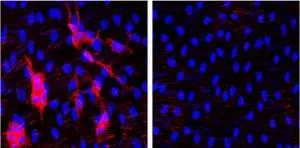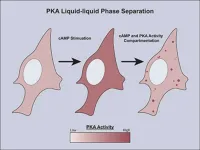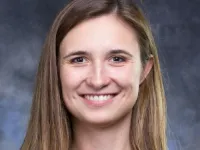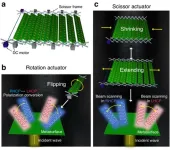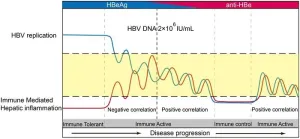(Press-News.org)
Dilated cardiomyopathy is the most frequent cause of heart failure in young people and is the leading cause of heart transplantation. In this disease, the heart enlarges and reduces its capacity to pump blood. People with dilated cardiomyopathy are at high risk for arrhythmias and sudden death.
In approximately 30%–40% of people with dilated cardiomyopathy, the disease is caused by a genetic mutation. When a genetic cause is identified, the patient’s family members can be studied to determine if they have also inherited the altered gene.
Family members who are carriers of the genetic mutation are at risk for developing the disease in the future, and it is recommended that they undergo regular check-ups so that any signs of the disease can be detected as soon as they appear and pharmacological treatments initiated.
Nevertheless, it is not known if all family members carrying the culprit mutation will go on to develop the disease, at what age this is more likely to happen, and if there are factors that could help to identify those individuals who are likely to show signs of disease over the short term and who would therefore benefit from closer monitoring.
The new study, led by Dr. Pablo García-Pavía, a researcher at the Centro Nacional de Investigaciones Cardiovasculares (CNIC), a group leader in the Spanish cardiovascular research network (CIBERCV), and a cardiologist at Hospital Puerta de Hierro, provides the first stratification of the risk of developing dilated cardiomyopathy among symptom-free genetic carriers of the disease.
A total of 25 Spanish hospitals participated in the study, which is published in the Journal of the American College of Cardiology. Data were collected from more than 779 genetic carriers, from 300 families, who had shown no signs of the disease before entering the study.
The researchers found that, after a median follow-up of 37 months, almost 11% of the genetic carriers had developed the disease.
The study also showed that the appearance of the disease was dependent on the specific type of genetic mutation present.
Moreover, said Dr. García-Pavía, “we found that patients who develop the disease tended to share certain characteristics, such as older age, electrocardiogram alterations, and an enlarged heart with a weaker pumping action, albeit within the normal range.”
Dr. García-Pavía added that “the risk for developing the disease was also higher in patients with mutations in sarcomere genes or in those whose hearts showed signs of fibrosis detected by magnetic resonance imaging.”
First author of the study, Dr. Eva Cabrera, a cardiologist at Hospital Puerta de Hierro, said “these results will allow us to offer more personalized care to genetic carriers with no disease symptoms.”
Currently, all genetic carriers receive a similar care strategy, consisting of annual or twice-yearly check-ups. “Now,” said Dr. Cabrera, “we can schedule check-ups to meet the specific needs of the individual patient: more spaced out for patients without risk factors, and more frequent for those at higher risk.”
The study was supported by the Sociedad Española de Cardiología (a Hereditary Cardiac Disease grant awarded in 2022) and the Instituto de Salud Carlos III through projects PI18/0004 and PI20/0320 (cofounded by the European Regional Development Fund/European Social Fund “A way to build Europe”/“Investing in your Future”).
About the CNIC
The CNIC is an affiliate center of the Carlos III Health Institute (ISCIII), an executive agency of the Spanish Ministry of Science, Innovation, and Universities. Directed by Dr. Valentín Fuster, the CNIC is dedicated to cardiovascular research and the translation of the knowledge gained into real benefits for patients. The CNIC has been recognized by the Spanish government as a Severo Ochoa center of excellence (award CEX2020-001041-S, funded by MICIN/AEI/10.13039/501100011033). The center is financed through a pioneering public-private partnership between the government (through the ISCIII) and the Pro-CNIC Foundation, which brings together 12 of the most important Spanish private companies.
END
As the World Health Organization (WHO) pushes for countries to seal the Pandemic Treaty by May this year, researchers at the University of Warwick and Kings College London stress the need for fair negotiations.
The opinion piece, featured in PLOS Global Public Health journal, is led by Professor Sharifah Sekalala . The team highlights the importance of considering "Time Equity" in these talks, urging caution on setting deadlines and sharing the burden when time is tight.
Since COVID-19 hit, demands for health equity ...
The International Society for Autism Research (INSAR) will hold its 2024 Annual Meeting – the organization’s 23rd – from Wednesday, May 15 through Saturday, May 18, 2024, bringing together a global, multidisciplinary group of more than 1,200 autism researchers, clinicians, advocates, self-advocates, and students from 20 countries to exchange the latest scientific learnings and discoveries that are advancing the expanding understanding of autism and its complexities. This year’s ...
Healthy cells respond appropriately to changes in their environment. They do this by sensing what’s happening outside and relaying a command to the precise biomolecule in the precise domain that can carry out the necessary response. When the message gets to the right domain at the right time, your body stays healthy. When it ends up at the wrong place at the wrong time, you can get diseases such as diabetes or cancer.
The routes that messages take inside a cell are called signaling pathways. Cells use only a few signaling pathways to respond simultaneously to hundreds of external signals, so those pathways need to be tightly ...
COS Mason Researchers Translating Research Into Practice To Create Climate-Ready Communities Across Virginia
Four Mason researchers received funding for: “ART: Translating Research into Practice to Create Climate-Ready Communities Across Virginia.”
Leah Nichols, Executive Director, Institute for a Sustainable Earth, Research and Innovation Initiatives; James Kinter, Professor, Climate Dynamics, Atmospheric, Oceanic and Earth Sciences (AOES); Director, Center for Ocean-Land-Atmosphere Studies (COLA); Luis Ortiz, Assistant Professor, AOES; and Celso Ferreira, Associate Professor, Sid and Reva Dewberry Department of Civil, Environmental, and Infrastructure Engineering, are ...
Hao Receives Funding for NOAA AMSU-A CDR Products Support ...
“Where is my life going?” “Who do I want to be?”
As future-thinkers, adolescents spend significant time contemplating these types of questions about their life goals. A new study from the University of Houston shows that as people grow from teenagers to young adults, they tend to change the importance they place on certain life goals, but one thing is certain: The existence of high prestige and education goals, as well as their positive development, can drive success.
“Adolescents who endorsed higher levels of prestige and education goals tended to have higher educational attainment, income, ...
Researchers have unveiled a technology that propels the field of wireless communication forward. This cutting-edge design, termed a reconfigurable transmissive metasurface, utilizes a synergistic blend of scissor and rotation actuators to independently manage beam scanning and polarization conversion. This introduces an innovative approach to boosting signal strength and efficiency within wireless networks.
Reconfigurable metasurfaces are transforming wireless communication by adjusting electromagnetic (EM) wave characteristics such as amplitude, phase, and polarization. These planar arrays enhance wave control, boosting functionalities ...
Background and Aims
Disease progression of chronic hepatitis B virus (HBV) infection is driven by the interactions between viral replication and the host immune response against the infection. This study aimed to clarify the relationship between HBV replication and hepatic inflammation during disease progression.
Methods
Two cross-sectional, one validation cohort, and meta-analyses were used to explore the relationship between HBV replication and liver inflammation. Spearman analysis, multiple linear regression, and logistic regression were used to explore the relationship between variables.
Results
In ...
Nathan Sleeter, Research Assistant Professor, History and Art History, Roy Rosenzweig Center for History and New Media (RRCHNM), is set to receive funding for: “American Indian Science and Engineering Society (AISES) at 50 website.”
RRCHNM researchers will develop a website that will tell the story of AISES’s first 50 years, its founding mission, its growth, and the individuals who have been part of its work supporting American Indians in STEM. Sleeter will serve as project director.
The researchers will also conduct and record oral history ...
Farhang Alem, Interim Director of the Biomedical Research Laboratory, Institute for Biohealth Innovation, received funding for: “PRNT Analysis of Samples from Athari BioSciences.”
Researchers with the Biomedical Research Laboratory will perform Plaque Reduction Neutralization Tests (PRNTs) on Athari patient serum samples with parameters defined by Athari. They will also produce and deliver a report containing all patient serum sample titer results for SARS-CoV-2.
PRNT analysis is a serological test that utilizes the ability of a specific antibody to neutralize a virus, and in turn, prevent the virus ...


